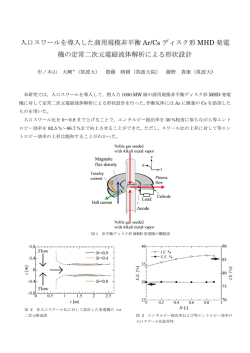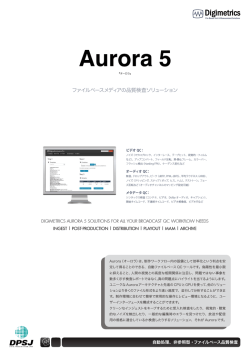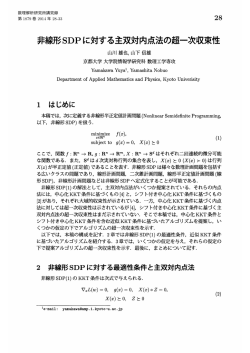
Document 606955
R006-P007 会場: Poster 時間: 11 月 5 日 シータオーロラ形成時における磁気圏構造とプラズマ対流:次世代磁気圏電離圏結 合系シミュレーションコードによる MHD モデリング # 小中原 祐介 [1]; 渡辺 正和 [2]; 田中 高史 [3]; 藤田 茂 [4]; 久保田 康文 [5]; 品川 裕之 [6]; 村田 健史 [6] [1] 九大・理・地惑; [2] 九大・理・地惑; [3] 九大・宙空センター; [4] 気象大; [5] NICT; [6] 情報通信研究機構 Magnetospheric structure and plasma convection associated with theta auroras : Next-generation M-I code simulation # Yusuke Konakahara[1]; Masakazu Watanabe[2]; Takashi Tanaka[3]; Shigeru Fujita[4]; Yasubumi Kubota[5]; Hiroyuki Shinagawa[6]; Ken T. Murata[6] [1] Earth and Planetary Sci., Kyushu Univ.; [2] Earth & planetary Sci., Kyushu Univ.; [3] SERC, Kyushu Univ.; [4] none; [5] NICT; [6] NICT A theta aurora is an optical phenomenon that consists of an "auroral oval" (a luminous ring) and a "transpolar arc (TPA)" that extends across the polar cap. Previous studies show that a theta aurora is formed when the IMF By sign changes during a prolonged IMF Bz > 0 period. In response to the IMF By change, a TPA starts from the dawnside or duskside aurora oval and moves toward the opposite side across the polar cap. Also, the characteristic of precipitating particles associated with the TPA is similar to that of the plasma sheet, indicating that the TPA is located on closed field lines. In spite of the vast efforts in the past, however, it is not yet understood how such an anomalous configuration is formed, how the magnetospheric structure reconfigures, and how field-aligned currents (FACs) and plasma convection evolve in the ionosphere and in the magnetosphere. The purpose of our study is to clarify such magnetosphere-ionosphere coupling processes during theta aurora formation using MHD simulation. Although earlier studies were successful in reproducing theta auroras by MHD simulation, because of the lack of spatial resolution of the numerical models, ionospheric convection and FAC patterns obtained by these studies were not amenable to comparison with observations. Recently, one of the authors (T. Tanaka) has developed a next-generation simulation code in which the solar wind-magnetosphere-ionosphere system is solved with sufficiently high spatial resolution so that ionospheric solutions are comparable to observations. In this code, very dense grids are allocated at the inner boundary of the magnetosphere in order to resolve ionospheric phenomena in detail. In addition, unlike the grid system based on polar coordinates, it does not have any singular points in the system, which enables us to increase the grid resolution as much as we like according as the computer power. Using this new code, as a first step, we simulate the simplest case in which IMF By exhibits a stepwise change during northward IMF periods. In the talk, we demonstrate the preliminary results of the theta aurora simulation and its analysis. In particular, we focus on (1) the detailed evolution of ionospheric plasma convection and FACs associated with theta auroras and (2) the physical interpretation of the magnetospheric structure during theta aurora formation. Acknowledgements. Data processing and other research work in the present study was performed with the NICT Science Cloud at National Institute of Information and Communications Technology (NICT) as a collaborative research project. シータオーロラとは、環状に現れる通常の発光領域“ オーロラオーバル ”と、極域を横断する発光領域“ トランスポー ラーアーク(TPA)”からなる発光現象のことである。過去の研究から、シータオーロラは IMF が北向きの間に IMF By の符号が変化すると形成される、ということがよく知られている。TPA は朝側・夕方側どちらかのオーロラオーバルか らはがれるようにして発生し、極域を横断するように反対側へ動くということが観測により確認されている。また、TPA 領域の降下粒子の特徴がプラズマシートのものと似ているということなども観測から明らかになっている。しかし、ど のようにしてこのような特異な形になるのかという物理的なメカニズムや、このときの磁気圏構造、沿磁力線電流のパ ターンなど総合的な様相はいまだに解明されていない。本研究の目的は、MHD シミュレーションでシータオーロラを再 現し、そのときの磁気圏構造や電離圏プラズマ対流などを調べて、シータオーロラ形成時の磁気圏-電離圏結合系を解明 することである。 これまでグローバル MHD シミュレーションでシータオーロラを再現した研究はいくつかあるが、モデルの解像度不 足から、観測と比較可能なほど詳細な電離圏ポテンシャル・沿磁力線電流のパターンを得たものはない。最近、著者の ひとり(田中高史)が電離圏現象の観測との比較を可能にする高空間分解能の太陽風−磁気圏−電離圏結合系 MHD シ ミュレーションコードを開発した。このコードは、電離圏の現象を特に詳しく見るために磁気圏内部境界付近のグリッド が非常に細かくなっており、かつこれまでの 3 次元極座標系のグリッドとは違いどこにも特異点を持たないという特徴 がある。この新コードを用いて、IMF 北向きのまま IMF By が矩形的に変化する最も簡単な場合の計算を行った。本講 演では、このシータオーロラのシミュレーションとその解析の初期結果を紹介する。特に、(1) シータオーロラに伴う電 離圏プラズマ対流・沿磁力線電流変動の詳細、(2) シータオーロラ形成時における磁気圏構造の変化の物理的解釈、につ いて論じる。 謝辞 本論文の研究は情報通信研究機構の NICT サイエンスクラウドを用いて行われました。
© Copyright 2025


